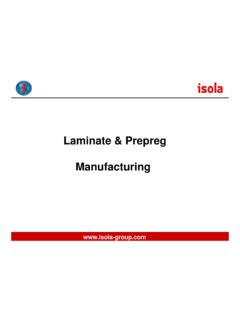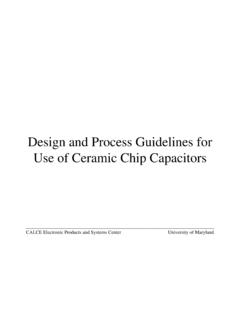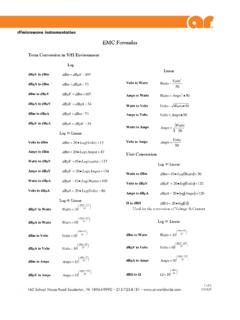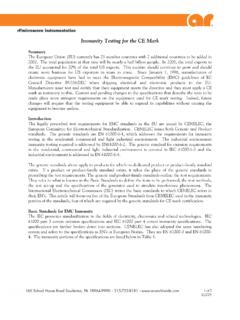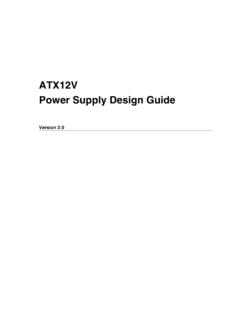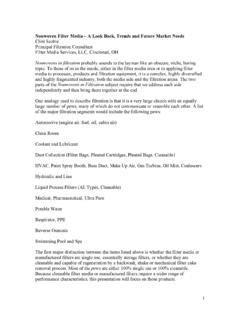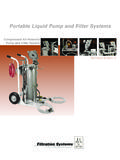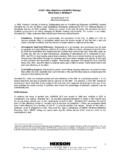Transcription of EMI Filter Design - Reverse engineering
1 P1: IML/OVYP2: IML/OVYQC: IML/OVYT1: IMLMHBD017-03 Sandler 6, 200518:53 Chapter3 EMI Filter DesignNearly all power circuits contain an input electromagnetic interference(EMI) Filter . The main purpose of the EMI Filter is to limit the inter-ference that is conducted or radiated from the power circuit. Excessiveconducted or radiated interference can cause erratic behavior in othersystems that are in close proximity of, or that share an input sourcewith, the power circuit. If this interference affects the power circuit, itcan cause erratic operation, excessive ripple, or degraded regulation,which can lead to system level problems. Input EMI filters may alsobe used to limit inrush current, reduce conducted susceptibility, andsuppress spikes. The specifications for the allowable interference aregenerally driven by the power circuit specification. The most commonspecifications include MIL-STD-461 for military applications and FCCfor commercial applications. Many other EMI specifications also chapter will deal with the Design and analysis of EMI filtersthat will reduce conducted interference and conducted susceptibilityand limit inrush current.
2 The Design of the input Filter is slightly morecritical when the power circuit is a regulated switching circuit, ratherthan a linear circuit, because a negative input resistance is created bythe regulated switching it is possible to simulate the radiated interference of apower circuit, it is beyond the scope of this RequirementsThe Design of an input EMI Filter begins with the definition of two basicrequirements: The Filter must provide the power converter with lower output impe-dance than the negative input resistance of the power : IML/OVYP2: IML/OVYQC: IML/OVYT1: IMLMHBD017-03 Sandler 6, 200518:5364 Chapter Three The input Filter attenuation must be sufficient to limit the resultinginterference to a level that is below the imposed following flowchart provides a step-by-step approach that may beused to Design an input Filter Design flowchartDefineImpedanceYESYESYESNOA ttenuationDefined?HarmonicContentKnownNO WaveformKnown?EstimateWaveformCalculate FouriercomponentsCalculateAttenuationCal culatecomponentValuesDefining the Negative ResistanceThe negative resistance of the power circuit can be defined by lookingat the following conditionsPin=PoutefficiencyIin=PinVinRi n=VinIin=V2inPin=V2in efficiencyPoutP1: IML/OVYP2: IML/OVYQC: IML/OVYT1: IMLMHBD017-03 Sandler 6, 200518:53 EMI Filter Design65 The input resistance is negative because as the input voltage in-creases, the input current decreases.
3 As a simple example, we can usePSpice to analyze the input resistance of the power circuit. PSpice cananalyze the input resistance in a number of ways. The simplest methodis the transfer function (.TF) analysis, which calculates the DC gainand the small signal input and output impedance. The following exam-ple uses the analysis to measure the input resistance of aswitching power 1 Input resistance analysisInput FileRIN: INPUT V(5) V1V15020G150 Value ={100/V(5)}.ENDO utput FileRIN: INPUT V(5) V1V15020G150 Value={100/V(5)}. SMALL-SIGNAL CHARACTERISTICSV(5)/V1 = +00 INPUT RESISTANCE AT V1 = +00 OUTPUT RESISTANCE AT V(5) = +00 The G1 source simulates a power circuit, which has an input power of100 W. V1 applies 20 VDC to the power circuit, and the .TF measuresthe input impedance at node 5 and the output impedance at V1. Theresults are placed in the output file. Note that PSpice calculated theinput impedance as a negative resistance of 4 ,which is in agreementwith the above the Harmonic ContentThe next step in designing an input EMI Filter is to determine the har-monic content of the power circuit input current.
4 If the input currentwaveform is known, a Fourier analysis can be performed in order to es-tablish the harmonic content of the waveform; however, even if the exactwaveform is not known, we can estimate the waveform with reasonableaccuracy. The Design can be optimized later, if the pulsating waveform in Fig. With a peak amplitudeof 1 and a base amplitude of 0, we can compute the Fourier series ofP1: IML/OVYP2: IML/OVYQC: IML/OVYT1: IMLMHBD017-03 Sandler 6, 200518:5366 Chapter ThreeInput Current 1 0 t T Duty Cycle = t/T Figure waveform used in the Fourier series follows:An=2Tt 0sin(nt)Bn=2Tt 0cos(nt)Cn= A2n+B2nIf we assume that the input ripple current is pulsating and if weknow the duty cycle, we can proceed to the Fourier analysis. If theduty cycle is not known, we will assume a value of 50%. This assump-tion is the worst case, because the Fourier analysis of a pulsed wave-form has a maxima at a value of 50%.
5 In the next example, we willuse SPICE to calculate the Fourier coefficients of a 50% duty 2 .FOUR analysisThe following example demonstrates the use of the .FOUR analysis. V1is a pulsed voltage source, which has a 50% duty cycle and a 100-kHzfrequency. The .FOUR statement calculates the magnitude and phaseof the DC value and the first nine harmonics. The result is placed inthe output file as shown : DEMONSTRATING THE USE OF THE .FOUR NUMDGT= .01U 100 KHZ V(1)V1 1 0 : IML/OVYP2: IML/OVYQC: IML/OVYT1: IMLMHBD017-03 Sandler 6, 200518:53 EMI Filter Design67 FOURIER COMPONENTS OF TRANSIENT RESPONSE V(1)DC COMPONENT = FREQUENCY FOURIERNORMALIZED PHASENORMALIZEDNO(Hz)COMPONENT COMPONENT(DEG)PHASE(DEG) + + + + + + + + + + + + + + + + + + + + + + + HARMONIC DISTORTION = +01 PERCENTAs you can see from the output file, the fundamental harmonic hasapeak value that is of the peak pulse amplitude. Although thisdoes provide the required information, it is far from elegant.
6 A bettersolution is to calculate the harmonics in Probe. The resulting plot isshown in Fig. is the worst case for a pulsed waveform and could be conserva-tively used for the Design of the input 3 Using the .STEP command to calculate harmonicsThe next example uses the PSpice .STEP command to sweep the dutycycle from 5% to 95% and look at the fundamental amplitude of theresulting square wave. As in the previous example, V1 is a pulsed (1)0V400mV800mVSEL>> Time0s2us4us6us8us10us12us14us16us18us20 usV(1) FFT feature of the Probe graphical waveform postprocessor is used tocalculate the harmonics of a square : IML/OVYP2: IML/OVYQC: IML/OVYT1: IMLMHBD017-03 Sandler 6, 200518:5368 Chapter Three V(1)-V(0) of the .STEP analysis. The waveform with the largest amplitude at 100kHz corresponds to the 50% duty cycle (TON= 5 s).voltage source. In this case, the pulse has an initial amplitude of1 Vand switches to 0 V after delay TON.
7 TON is swept from the simulation is finished, you can use Probe to display theX-Y data, or you may view the output file in a text editor. You willhave a graph of the fundamental harmonic versus TON. This confirmsthe previous statement that the 50% duty cycle was the maxima andprovides a reference you may find helpful in the : .STEP TON= PARAM TON .1U TRAN V(1)V1 1 0 PULSE 1 0{TON}.ENDThe FFT results of the .STEP analysis are shown in the graphs ofFigs. and 4 EMI Filter designIn order to Design the EMI Filter , we need to define a converter thatwill operate with it. For the purpose of this example, let us assume thatwe have a power converter that will operate with an input voltage of18 to 32 V DC. The converter output power will be 75 W and will havean operating efficiency of 75%. The converter will have a switchingfrequency of 100 kHz. The conducted emissions requirement allows the1-mA peak to be reflected back to the input lines.
8 A second-order filterwill be : IML/OVYP2: IML/OVYQC: IML/OVYT1: IMLMHBD017-03 Sandler 6, 200518:53 EMI Filter in Amplitude in VoltsFundamental Harmonic vs Ton for 10uSec Pulse TrainFigure analysis result shows the 50% duty cycle as the us follow the procedures that were defined in the EMI designflowchart. Step 1 is to calculate the input the input input impedance was defined ear-lier in this chapter asV2in efficiencyPoutIt is obvious that the lowest impedance will occur at the minimum inputvoltage. This value can be calculated as182 Calculating the harmonic no detail is provided regard-ing the pulse current waveforms, we will assume that the duty cycle is50%. The average input current isIavg=PoutVin efficiency=7518 a duty cycle of 50%, the peak amplitude will be A. In theprevious harmonic analysis, we defined the fundamental harmonic tobe : IML/OVYP2: IML/OVYQC: IML/OVYT1: IMLMHBD017-03 Sandler 6, 200518:5370 Chapter ThreeCalculating the required a maximum reflected ripplecurrent of 1-mA peak, we can define the attenuation required asAttenuation= dBCalculating the component attenuation for a second-orderfilter can be defined asAttenuation= fswitchffilter 2 Wecan compute the Filter frequency as100 kHz Attenuation=100 values ofLandCcan be defined by setting their impedances tothe input converter input impedance at the Filter resonant frequency,as defined 1188 = FL= 1188 434 HNote that the characteristic impedance of the Filter is defined byZo= LC= 434 F= which is equal to the converter input impedance.
9 In an actual Design ,it is a good practice to provide a 6-dB margin for these ElementsWhile this Filter provides the proper impedance matching and the re-quired attenuation, the impedance will be quite high at the resonantfrequency of the Filter . The only damping elements in the circuit are theDC resistance (DCR) of the inductor and the equivalent series resis-tance (ESR) of the capacitor (which we have not defined). It is normallynecessary to provide damping of the L-C Filter in order to restrict theimpedance of the Filter at the resonant frequency. A shunt series R-Cnetwork is used for this purpose. The value of the damping capacitoris generally 3 to 5 times greater than that of the Filter capacitor, andP1: IML/OVYP2: IML/OVYQC: IML/OVYT1: IMLMHBD017-03 Sandler 6, 200518:53 EMI Filter (1)R1 RDAMP12 (1) of the test circuit used to measure the impedance of the Filter . Thewaveform V(1) is equivalent to the impedance because the input is a current (I1 1 0 AC1).
10 The case for CDAMP = 120 and RDAMP= is value of the damping resistor is generally close to the characteristicimpedance of the Filter . The PSpice .Step command is ideal for definingthese following circuit is designed to measure the impedance of the fil-ter, while sweeping the damping capacitor from 120 to 200 Fin40- Fincrements. For each value of the damping capacitor, the damping re-sistor will be swept from to 2 times the characteristic impedance( to ) increments. The PSpice listing and schematic ofthe test circuit (Fig. ) are shown results are shown : TO MEASURE THE IMPEDANCE OF A DEC 10 100HZ CDAMP= RDAMP= PARAM CDAMP 120U 200U PARAM RDAMP . 1 0 : IML/OVYP2: IML/OVYQC: IML/OVYT1: IMLMHBD017-03 Sandler 6, 200518:5372 Chapter ThreeC212{CDAMP}R120{RDAMP}I101AC1L1 0 1 results are provided in the output file and are shown Analysis of + + + + + + + + + + + + + + + + + + + + + + + + + + + impedance was exceeded with the 120- Fdamping capacitor(Fig.)
